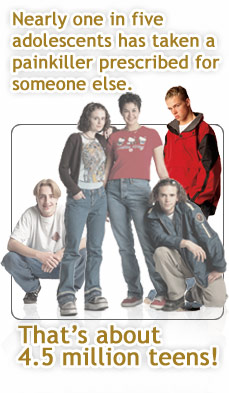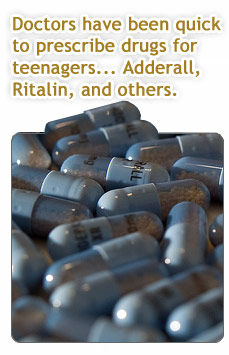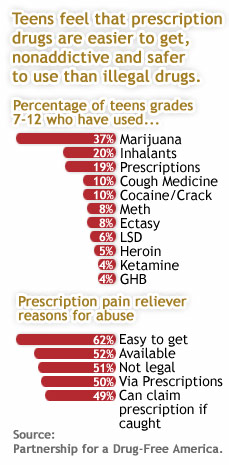  We all know that drug abuse is one of the most pervasive problems in America (and has been for some time). But, these days, if you think illicit street drugs like marijuana and cocaine are mostly to blame -- think again.
In fact, teen abuse of drugs like marijuana is falling, according to a study called Monitoring the Future. Such great news, however, comes with a sobering reality: Teen abuse of prescription and over-the-counter drugs is rising -- rapidly. According to a recent study by The Partnership for a Drug-Free America, nearly one in five adolescents has taken a painkiller prescribed for someone else. That's about 4.5 million teens.
If pressed, many teens would probably admit that prescription drugs are much easier to get than street drugs. That's a scary thought. While manufactured by legitimate companies for specific purposes, such drugs can be dangerously addictive, and many are deadly if abused, particularly when combined with other drugs or alcohol. (Remember that actor Heath Ledger died in February of an accidental overdose of six different drugs, including the painkiller oxycodone and the anti-anxiety pills Valium and Xanax.)
Where are kids getting these drugs?Believe it or not, parents are prime sources. Why? As the drug dealer in one anti-drug commercial says, "Seems like half of my customers, they don't even need me anymore. They're getting high for free. Out of the medicine cabinets. How am I supposed to compete with that?"
It's a big problem. If you have a child about 12 or older, and your medicine cabinet contains pills for pain, mood, or stimulation, or cough syrup with dextromethorphan, you need to be aware of their potential for abuse. No way, not my child, you say? You're probably right. But, like many parents around the United States who have suffered shock and misery in this area, you might just as easily be wrong.
"An awful lot of people have prescription drugs in their houses," says Lloyd Johnston, PhD, program director and distinguished senior research scientist at the University of Michigan's Institute for Social Research. "Parents need to go through their medicine cabinets and locate any abusable drugs. If there are extra pills after a prescription period is over, throw them out. If you feel the need to keep extra pills around, lock them up. Parents also need to model good behavior for their kids, not only with pills, but with alcohol and tobacco."
Parents aren't the only potential sources. If your child has friends taking medications, or older relatives living nearby -- grandparents, for example, who take pain medication -- or older friends with credit cards and access to the Internet, they may have easy access to prescription drugs.
"Very few teens are getting drugs over the Internet themselves," says Johnston, a principal investigator in the Monitoring the Future study. "More frequently, the Internet is a source for intermediate dealers. However, teens, like everyone else, are barraged by ads for drugs. The Internet may make them more susceptible."
 How did this happen?If throwing out unused pills is a field tactic, the overall strategy should be our admission that today's popular culture harmfully condones prescription drug use.
"Three quarters of this problem is the consequence of big business and advertising," says David A. Deitch, PhD, a professor of clinical psychiatry at the University of California, San Diego, and chief clinical officer of Phoenix House, a leading treatment center for substance abuse. "The pressure both to prescribe and take these drugs has increased through the media. For years now, doctors have been very quick to prescribe drugs for teenagers, especially for attention deficit hyperactivity disorder (ADHD) -- Adderall, Ritalin, and others."
Meanwhile, parents, and kids themselves, easily get prescriptions for potent drugs for sleep and relaxation, depression and anxiety, pain, sexual problems… the list goes on and on.
"One consequence," says Deitch, "is that a lot of these drugs are found today out in the workplace, in the business environment, especially where there are a lot of young college graduates who were prescribed these drugs and may still have prescriptions. There's a lot of trading and bartering, depending on what people think they need to perform better. Someone might trade a stimulant for a depressant or a painkiller, depending on the time of day and what they think they might need to perform better at a certain task. Young people certainly know the effects of these drugs, and their perception of safety is not delusional -- the drugs are advertised and promoted as safe. They're legal, and they are easier to get simply because they're legal. They do not have the stigma of illicit drugs."
Which leads to some astounding figures: According to The Partnership for a Drug-Free America 40% of teenagers believe that prescription drugs are "much safer" than illegal drugs, 31% say there's "nothing wrong" with prescription drug use, and 29% think prescription painkillers are not addictive.
While today's teens have been barraged with warnings about the evils of illegal drugs, and correctly so, they've heard little about the dangers lurking in their own medicine cabinets. No wonder they have such a skewed sense of reality.
One way to change current trends, though, is to change perception.
 "The genie is already out of the bottle," says Deitch. "The answer isn't necessarily to enact more laws, or crack down on doctors or corporate advertising or Internet pharmacies, although all have played roles in this problem. The answer is education."
To learn more about the abuse of prescription and over-the-counter drugs, visit The Partnership for a Drug-Free America website and drugfree.org/resources (a website sponsored by the organization's joint initiative with the White House, The National Youth Anti-Drug Media Campaign). Both are excellent clearinghouses of references, linked resources, and practical advice.
You can also find useful lists of commonly abused prescription drugs online. We've adapted one from a National Institute on Drug Abuse chart. We've listed the reasons teens are taking these drugs.
Popular prescription and over-the-counter medicines commonly abused by teens include:
Depressants- Barbiturates: Amytal, Nembutal, Seconal, Phonobarbital
- Benzodiazepines: Ativan, Halcion, Librium, Valium, Xanax
- Flunitrazepam: Rohypnol
These substances can reduce pain and anxiety. They produce feelings of well-being and lower inhibitions. Flunitrazepam, in particular, is associated with memory loss during the time the drug is active in someone's system. It is also known as the "forget-me" pill.
Opioids and morphine-based painkillers- Codeine: Empirin with Codeine, Fiorinal with Codeine, Robitussin A-C, Tylenol (acetaminophen) with Codeine
- Fentanyl: Actiq, Duragesic, Sublimaze
- Morphine: Roxanol, Duramorph
- Other opiod pain relievers (oxycodone, meperidine, hydromorphone, hydrocodone, propoxyphene): Tylox, OxyContin, Percodan, Percocet, Demerol, meperidine hydrochloride, Dilaudid, Vicodin, Lortab, Lorcet, Darvon, Darvocet
These medications reduce pain, can promote euphoria, and cause drowsiness.
Stimulants- Amphetamines: Biphetamine, Dexadrine
- Methamphetamine: Desoxyn
- Methylphenidate: Ritalin
Stimulants increase feelings of exhilaration, energy, and metal alertness.
Other prescription drugs abused experimentally- Sexual dysfunction drugs: Viagra, Levitra
- ADHD drugs: Adderall, Ritalin, Concerta
- Antidepressants: Prozac, Zoloft, Selexa, Paxil, Wellbutrin, Effexor, Serzone
- Decongestants: Sudafed and others
- Cough medicines: Coricidin Cough and Cold, Robitussin, NyQuil, those containing dextramethorphan (DXM
- Sleeping pills: Ambien, Unisom
|